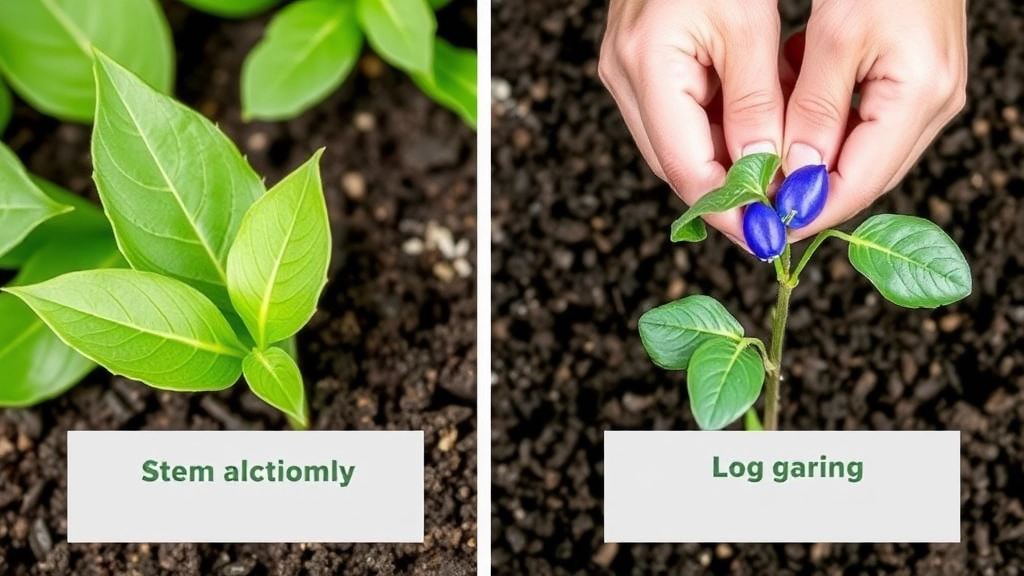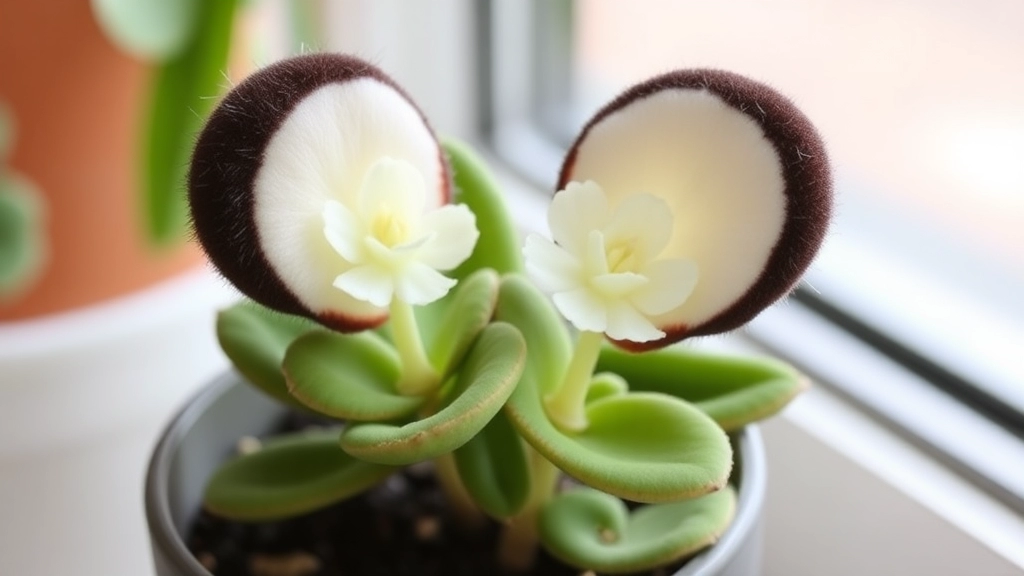Kalanchoe Panda Ears Care Guide
If you’re looking to keep your Kalanchoe Panda Ears thriving, you’ve come to the right place. Known for their fuzzy, panda-like leaves, these succulents are a favourite among plant enthusiasts. In this guide, I’ll share essential care tips, propagation methods, and solutions to common issues, ensuring your Panda Plant stays healthy and vibrant.
Basics of Kalanchoe Panda Ears Care
First, let’s dive into the basics of Kalanchoe Panda Ears care. These plants love bright, indirect sunlight and prefer well-draining soil to prevent root rot. Water sparingly, allowing the soil to dry out completely between watering sessions.
Propagation Methods
For propagation, leaf and stem cuttings are your best bet. Simply cut a healthy leaf or stem, let it callous over, and plant it in a succulent mix. With proper care, your Panda Plant will flourish.
Essential Care Tips for Kalanchoe Panda Ears
If you’re wondering how to keep your Kalanchoe Panda Ears thriving, you’re not alone. Many plant enthusiasts face challenges in maintaining the health of their succulent plants.
Here are some essential care tips to ensure your Kalanchoe Panda Ears flourish:
- Watering:
- Allow the soil to dry out completely between waterings.
- Water less frequently in winter; once every 2-3 weeks is often sufficient.
- Fertilising:
- Use a balanced, water-soluble fertiliser during the growing season (spring and summer).
- Fertilise every 4-6 weeks for optimal growth.
- Pruning:
- Remove any dead or wilted leaves to promote new growth.
- Prune back leggy stems to encourage a bushier appearance.
- Humidity:
- Kalanchoe Panda Ears prefer low humidity; ensure good air circulation around the plant.
- Potting:
- Use pots with drainage holes to prevent root rot.
- Consider using terracotta pots, as they help wick away excess moisture.
For more detailed advice on caring for different Kalanchoe varieties, you might find our Kalanchoe Paddle Plant Care Guide helpful. Additionally, if you’re interested in learning about the health benefits of Kalanchoe, check out our article on the health benefits of Kalanchoe Pinnata.
Propagation Methods: Leaf and Stem Cuttings

So, you’ve got your Kalanchoe Panda Ears thriving, and now you’re wondering how to multiply that joy?
Propagation is a fantastic way to expand your plant family.
Leaf Cuttings
- Choose Healthy Leaves: Look for plump, vibrant leaves. They should be free from any blemishes or pests.
- Cut with Care: Use a clean, sharp knife or scissors to snip the leaf. Aim for a clean cut to avoid damaging the plant.
- Let it Callus: Place the leaf in a dry spot for a few days. This helps the cut end callus over, reducing the risk of rot when you plant it.
- Planting: Once callused, lay the leaf on top of well-draining soil. You can lightly press it into the soil, but no need to bury it.
- Water Sparingly: Mist the soil lightly. Too much water can lead to rot, so keep it on the dry side.
Stem Cuttings
- Select a Healthy Stem: Look for a stem that’s sturdy and has a few leaves.
- Cut Below a Node: Just like with leaf cuttings, use a clean tool. Cut just below a node where the leaves grow.
- Let it Callus: Allow the cut end to dry out for a couple of days.
- Planting: Insert the stem into well-draining soil, burying it about an inch deep.
- Watering: Give it a light drink and keep the soil slightly moist but not soggy.
Bonus Tips
- Humidity Matters: If you can, cover your cuttings with a plastic bag or a dome to maintain humidity. Just remember to vent it occasionally.
- Patience is Key: It might take a few weeks for roots to develop, so don’t rush it!
Ideal Soil and Watering Needs for Healthy Growth
When it comes to nurturing your Kalanchoe Panda Ears, the right soil and watering regimen are pivotal for robust health. Many plant enthusiasts often wonder, “What type of soil does my Kalanchoe need?” or “How often should I water it?” Let’s dive into these essential care tips.
Soil Requirements
Kalanchoe Panda Ears thrive in well-draining soil, which is crucial to prevent root rot. Here are some tips for selecting the right soil:
- Cactus Mix: A pre-packaged cactus or succulent mix works wonders.
- DIY Mix: Combine regular potting soil with sand or perlite to enhance drainage.
- pH Level: Aim for a slightly acidic to neutral pH (around 6.0 to 7.0).
Watering Needs
Watering is where many plant owners falter. Overwatering can lead to serious issues, while underwatering can stunt growth. Here’s how to strike the right balance:
- Frequency: Water when the top inch of soil feels dry. This usually translates to every 2-3 weeks, depending on your environment.
- Method: Water thoroughly until it drains from the bottom of the pot. Always discard excess water in the saucer.
- Seasonal Adjustments: Reduce watering in the winter months when the plant is dormant.
Tips for Healthy Growth
- Signs of Overwatering: Yellowing leaves or mushy stems indicate too much water.
- Signs of Underwatering: Wrinkled leaves or a plant that looks droopy suggests it’s thirsty.
For more detailed information on the care and propagation of Kalanchoe Panda Ears, check out our complete guide. Additionally, if you’re interested in exploring other varieties, our varieties care guide is a great resource.
Light and Temperature Preferences for Kalanchoe Panda Ears

When it comes to nurturing Kalanchoe Panda Ears, understanding their light and temperature needs is crucial. Many plant enthusiasts often wonder, “How much light does my Kalanchoe need?” or “What temperature is best for it to thrive?”
Light Requirements:
- Bright, Indirect Light: Kalanchoe Panda Ears flourish in bright, indirect sunlight.
- Avoid Direct Sunlight: While they can tolerate some direct sun, prolonged exposure can scorch their delicate leaves.
- Ideal Locations: A spot near a window with filtered light is perfect.
Temperature Preferences:
- Optimal Range: These plants prefer temperatures between 20°C to 25°C (68°F to 77°F).
- Avoid Extremes: They do not fare well in temperatures below 10°C (50°F) or above 30°C (86°F).
- Seasonal Changes: During winter, ensure they are kept away from cold drafts and heating vents.
By providing the right light and temperature, you set the stage for vibrant growth and robust health in your Kalanchoe Panda Ears.
Common Pests and Diseases and How to Treat Them
When caring for your Kalanchoe Panda Ears, it’s essential to keep an eye out for potential pests and diseases that can hinder its growth.
Common Pests
- Mealybugs
These small, white, cotton-like bugs can cluster on the leaves and stems.
Treatment: Wipe them off with a cotton swab dipped in rubbing alcohol or use insecticidal soap. - Aphids
Tiny green or black insects that suck sap from the plant, leading to stunted growth.
Treatment: Spray with a strong stream of water or apply neem oil. - Spider Mites
These pests thrive in dry conditions and can cause yellowing leaves.
Treatment: Increase humidity and spray with water or insecticidal soap.
Common Diseases
- Root Rot
Caused by overwatering, leading to mushy roots.
Prevention: Ensure well-draining soil and allow the top inch of soil to dry out between waterings. - Leaf Spot
Dark spots on leaves, often due to fungal infections.
Treatment: Remove affected leaves and improve air circulation around the plant. - Powdery Mildew
A white, powdery substance on leaves, indicating high humidity.
Treatment: Increase airflow and remove infected leaves.
Prevention Tips
- Regular Inspection: Check your plant weekly for any signs of pests or diseases.
- Proper Watering: Avoid waterlogged soil to prevent root rot. For more details on watering practices, check out our watering best practices guide.
- Good Air Circulation: Ensure your plant has enough space to breathe to reduce the risk of fungal infections. For comprehensive care tips, refer to our complete guide to caring for Kalanchoe Panda Plant.
Repotting Techniques to Encourage Growth
So, you’ve been nurturing your Kalanchoe Panda Ears, and now you’re wondering if it’s time to repot? This is a common concern, and it’s great that you’re thinking about it! Repotting can give your plant a fresh start and plenty of room to grow.
When to Repot
- Signs Your Plant Needs a New Home:
- Roots are poking out of the drainage holes.
- The soil dries out too quickly.
- Growth has stalled or slowed.
Choosing the Right Pot
- Size Matters:
- Always go for a pot that’s 1-2 inches larger in diameter than the current one.
- Material:
- Terracotta pots are fantastic for succulents because they allow for better airflow and drainage.
The Repotting Process
- Gather Your Tools:
- New pot
- Well-draining soil (cactus mix works wonders)
- Trowel
- Water
- Remove the Plant:
- Gently squeeze the pot to loosen the soil.
- Carefully pull the plant out, holding it by the base.
- Inspect the Roots:
- Trim any brown or mushy roots. Healthy roots should be white and firm.
- Add Fresh Soil:
- Place a layer of fresh soil at the bottom of the new pot.
- Position your Kalanchoe in the centre and fill around it with more soil.
- Watering:
- Give it a light watering to settle the soil.
- Avoid overwatering immediately after repotting.
Aftercare Tips
- Keep it in a Shady Spot:
- After repotting, let your plant adjust in a shaded area for a week or so.
- Monitor for Stress:
- Watch for wilting or yellowing leaves, which can indicate stress.
For more detailed information on how to care for your Kalanchoe, check out our complete guide on Kalanchoe Tomentosa care. Additionally, if you’re interested in exploring different Kalanchoe varieties, our top Kalanchoe varieties with pink edges article might be just what you need!
FAQs about Kalanchoe Panda Ears
What are the best methods to propagate Kalanchoe Panda Ears?
There are two main methods for propagating Kalanchoe Panda Ears: leaf cuttings and stem cuttings. Both methods are effective and can help you expand your plant collection.
How do I propagate Kalanchoe Panda Ears using leaf cuttings?
To propagate using leaf cuttings, choose healthy leaves, cut them with care, let them callus, plant them on well-draining soil, and water sparingly. This method helps prevent rot and encourages root development.
What steps should I follow for stem cuttings propagation?
For stem cuttings, select a healthy stem, cut below a node, let it callus, plant it in well-draining soil, and water lightly. This method ensures the stem has the best chance to develop roots and grow.
Can I increase humidity for my cuttings to help them root?
Yes, covering your cuttings with a plastic bag or a dome can help maintain humidity. Just remember to vent it occasionally to prevent mold and mildew.
How much light does a Kalanchoe Panda Ears need?
Kalanchoe Panda Ears thrive in bright, indirect light. They can tolerate some direct sunlight but prolonged exposure may scorch their leaves. A spot near a window with filtered light is ideal.
What is the optimal temperature range for Kalanchoe Panda Ears?
The optimal temperature range for Kalanchoe Panda Ears is between 20°C to 25°C (68°F to 77°F). They do not fare well in temperatures below 10°C (50°F) or above 30°C (86°F).
Should I be concerned about seasonal changes for my Kalanchoe Panda Ears?
Yes, during winter, it’s important to keep your Kalanchoe Panda Ears away from cold drafts and heating vents to ensure they remain healthy and vibrant.
How long does it take for Kalanchoe Panda Ears cuttings to develop roots?
It can take a few weeks for roots to develop in Kalanchoe Panda Ears cuttings. Patience is key, so don’t rush the process.
What type of soil is best for planting Kalanchoe Panda Ears cuttings?
Well-draining soil is essential for planting Kalanchoe Panda Ears cuttings. This helps prevent waterlogging and root rot, providing the best environment for growth.
References
-
How to Grow Kalanchoe Panda Plant
-
Kalanchoe Propagation: How To Propagate Kalanchoe
-
Kalanchoe: How to Grow and Care for Kalanchoe Plants
